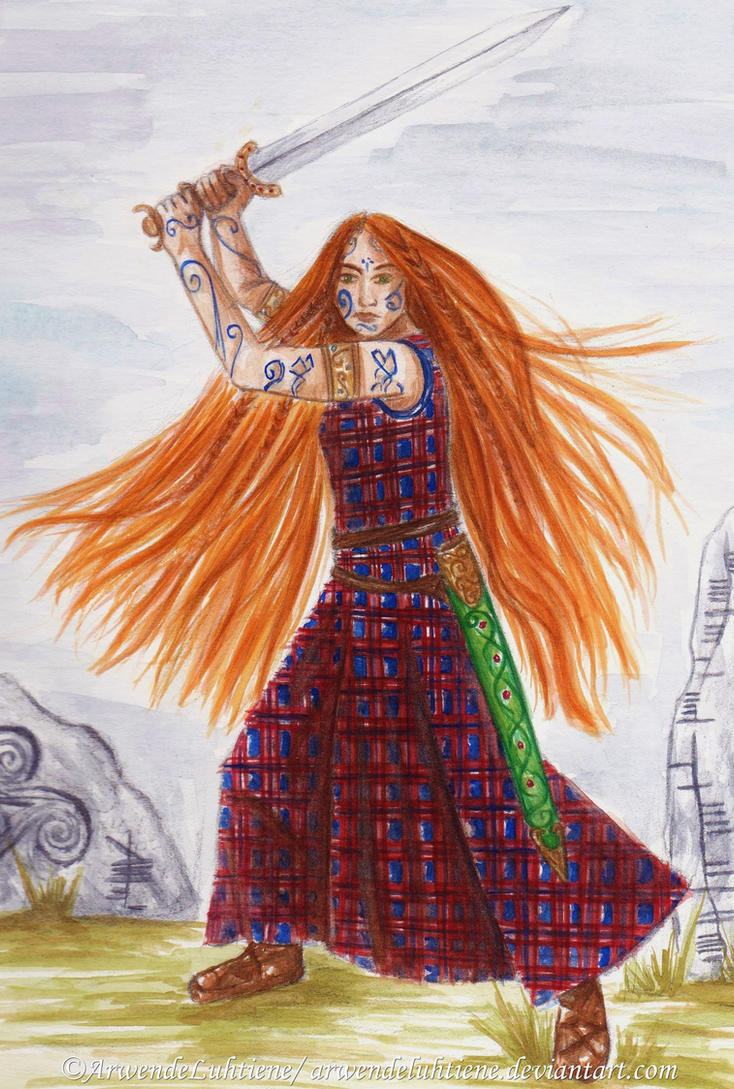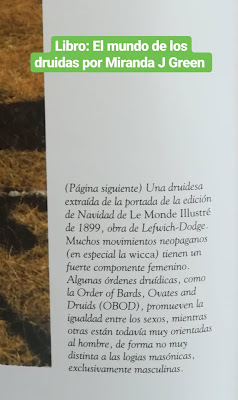Book: Exploring the World of the Druids (Spanish translation - El mundo de los druidas), by Miranda J. Green

As I read the Spanish translation of this book, the quotes and some of the commentary will be in Spanish in the case of this post.
I found this book to be a well-researched, well-structured and engaging
work about the world of the druids. The book starts with a series of
chapters delving into what we know about the druidism of Ancient Celtic
societies, from Classic author commentaries to archaeological findings,
then discusses the Celtic revival and rekindled interest about the
ancient druids in the 18th-19th Century (complete with all the
misconceptions from the times linking druids to megalithic monuments
xD), and finishes with a couple of chapters about modern neopaganism and
neodruidism.

 My sketches of druidesses (Source 1 and 2)
My sketches of druidesses (Source 1 and 2)


+1 The book also includes a whole chapter discussing the role of women
in ancient druidry, focusing on Classic references, mythological
mentions and archaeological depictions of druidesses and priestesses.
After the review I'll also post a series of IG stories with some excerpts from this chapter.
+1 I also liked the objective, non-binary, 'grey-morality-mindset'
approach to discussing a series of subjects. Instead of taking a side as
some authors sometimes do in this cases, for example, the author
objectively points out issues such as the fact that, when writing about
the druids and their religion, Roman authors (and also 18th-19th authors
during the revival) tended to both demonize them (thanks to xenophobic
colonialism and double standards) *and* also often offered an overly
idealized view of them (ignoring dodgy religious traditions such as
(human) sacrifice, for example) - While pointing out that neither
approach was that accurate or complete.
I liked that neutral, scientific approach of discussing all approaches
without contributing to either promoting a problematic 'uncivilized
people' mindset, or erasing objectionable aspects of a culture (as it's
still done today when discussing 'exotic' far away subjects such as
Celtic culture, a topic so influenced by the idealized lens of the myths
and the modern Revival).
+1 When talking about the modern druid orders from the 18th-19th Century
to the present, I also liked that the author pointed out the fact that
many of these groups had patriarchal foundations with only male members,
and that only relatively recently has neodruidism (especially in groups
such as OBOD, the Order of Bards, Ovates and Druids) come to consider
gender equality more seriously when it comes to their members. I also liked
the references to modern witchcraft and neopaganism being strongly
linked with the feminist movement, especially in the USA.
-1 One thing I did found a bit confusing, especially considering the
level of research of this book: A couple of (potentially ambiguous)
references comparing Christianity with ancient pagan religions (such as
druidism or Roman polytheism) seemed to imply that one difference
between the mindset of Christian religion and pagan ones is that pagan
religions were more interested and more strongly linked with material
aspects such as power (be it political or financial), while Christian
priests had 'moral' issues of dealing with 'achieving the salvation of
the people' as their main aim. She even states that it is 'surprising'
to see druidry (or Roman religion) so linked with political power.
If this is what the author meant, then it is technically incorrect on all levels, and it baffles me, considering the objectivity and level of research of the rest of the book. Christianity, as all organized religions, was strongly linked with political and financial power as well, *incredibly* so, and still is today :S And *all* religions - albeit some more than others, and the Abrahamic ones might certainly take the cake :S xD - always have to do with supposedly 'moral' issues, dealing with societal behaviour to a greater or lesser degree (druidism very much included - For example, the druids taught the belief of reincarnation, which meant warriors were more fearless and thus better in battle, which always suits political issues. Their main aim certainly wasn't giving altruistic hope). This 'moral content' generally acts as a very effective brainwashing tool in all cases, which is obviously linked with power as well. And, contrary to the author's wordings, I do not consider the modus operandi of Christian priests or any religious participant to deal with 'ethical' issues in the slightest - Ethics does not mean control and ruling through fear and superstition, which is what religious teachings normally intend to do.
- Excerpts about Celtic women and druidesses
These are stories from my personal (non-cosplay) Instagram, @martaluthien. You can also find the stories in my 'Feminist reviews 2-3' and 'Celtic world 1' highlights.
-Women in Ancient Celtic Society:
-Druidesses and priestesses - Classical mentions and archaeological finds
-Druidesses, priestesses and magical women in Irish myth, featuring Fedelm and Scáthach:
 |
| Fedelm, the armed poetess with foresight and druidic attributes from the Táin |
 |
| Fedelm and Queen Medb, by Ayrtha on DeviantArt |
 |
| My painting of warrior Scáthach, who also had druidic prophetic attributes |
- More about druidesses:
Source of the article: Ancient Celtic women by Metal Gaia
 |
| French painter Virginie Demont-Breton (1859-1935). She had quite a successful painting career, served as the president of the Union of Women Painters and Sculptors, and managed to open, alongside feminist and sculptor Hélène Bertaux , an art school exclusively for female students (as women were not admitted to the École des Beaux-Arts, thanks, Patriarchy). Van Gogh painted a version of one of her works, but of course I always knew about him and didn't know about this cool female artist until recently :S |
I love all these 19th Century depictions of druidesses I've been showing here (and yay for late 19th Century female artist Virginie Demont-Breton :D), but there's also a double standard that I also think is worthy of mention - The fact that, while male druids are generally depicted in the stereotypical image of the wise and venerable bearded man, female druids are here pretty much always depicted as young and societally attractive. We of course also have the mostly negative stereotpypical image of the witch as an old (ugly) woman, a blatant double standard compared to the positive figure of the old and wise wizard. Like, male gaze and sexist stereotypes don't show anywhere, oh no :S

And finally, to xit with some more feminist commentary xD, all this reminded me of a pretty jarring moment in the deplorable sexist-fest that is the comic of Astérix and the Secret Weapon (La Rose et le Glaive).
Since childhood I've hated the way the authors take the issues of feminism and female empowerment and play them for cheap laughs, with a good share of the most basic sexist stereotypes in Patriarchy's repertoire you could imagine :S :/
This scene specifically, coming from someone who loves the characters of Astérix and druid Panorámix (Getafix), is especially cringy and frustrating - A conversation between two of the characters most described as wise, intelligent, sensible and logical that starts as what looks like actual feminist ally content, but ends with cheap sexism for laughs :S Panorámix/Getafix seemingly starts talking about women's rights and how times are changing, and then instantly snorts at the mere idea of women being able to be druidesses (so frustrating not only because of the sexism but also because of the historical inaccuracy of that fact :S). And yeah, when you're a little girl and the Astérix comics become pretty much your first actual fandom that you're incredibly hyped about, and you want to be a warrior woman and a druidess thanks to the role models of Astérix and Panorámix - Seeing your role models basically laugh at the extravagant idea of women being able to be things and do things is pretty upsetting :S Which is why representation and allies matter so much.













































Estupenda información, interpretación y comentarios, como siempre. Soy fan.
ReplyDeleteLo acabo de releer y me encanta :)
ReplyDelete